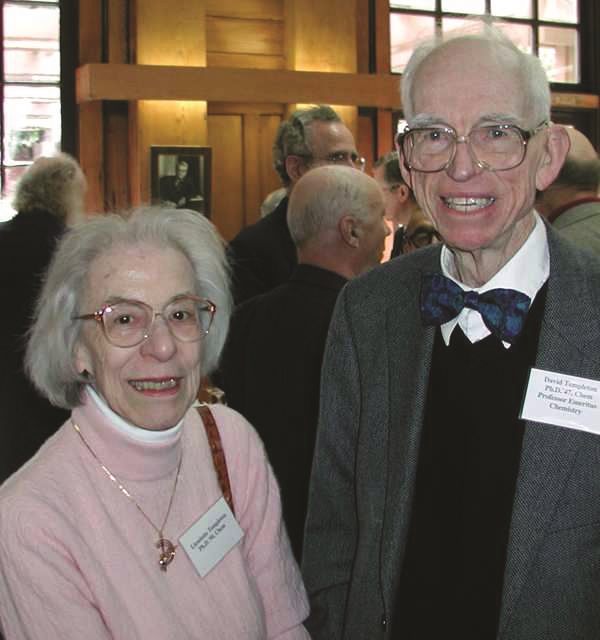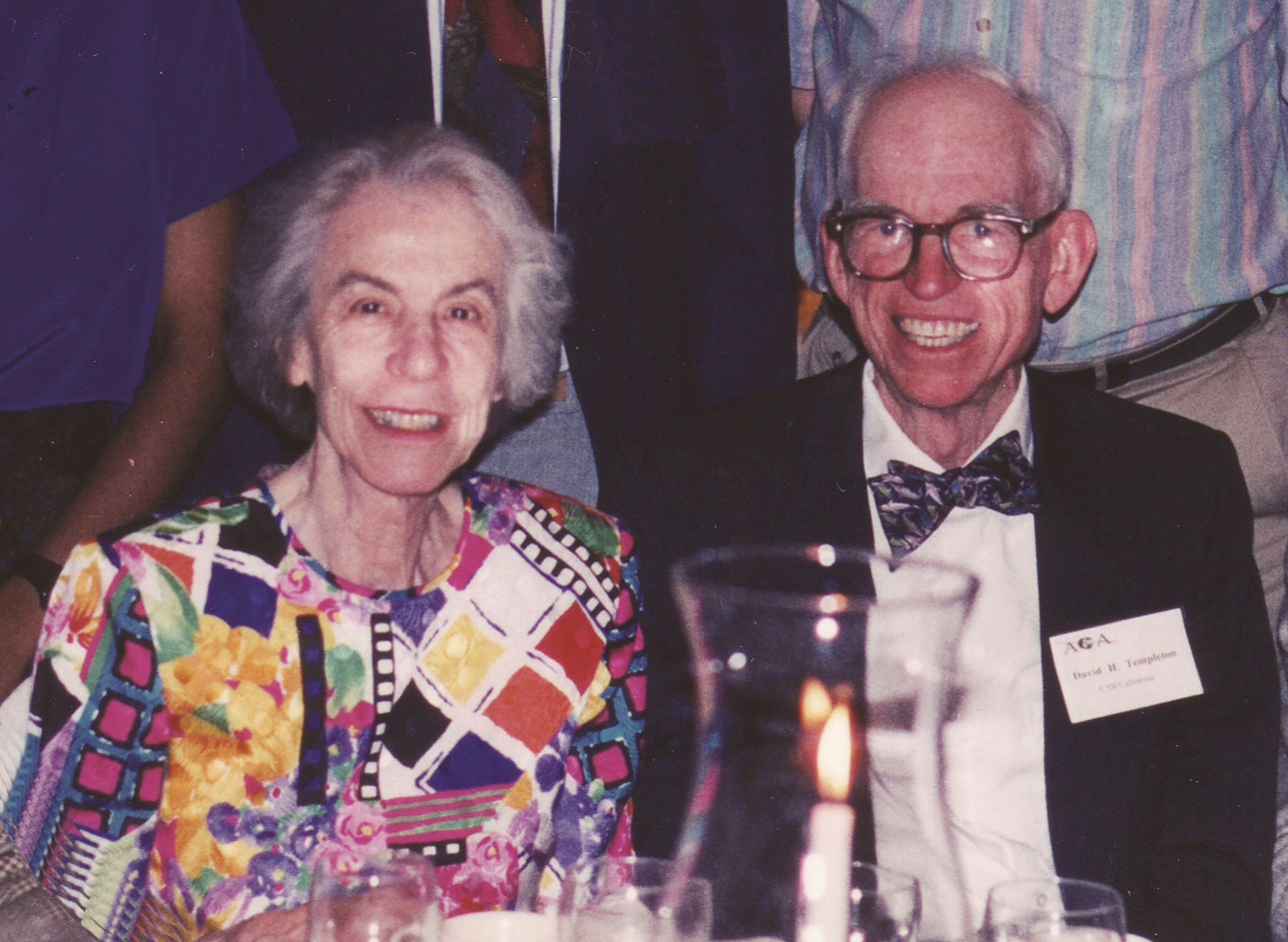- History Home
- People, Leadership & Service
- A Legacy of Excellence
- History & Impact
- Meetings Through the Years
- Resources
Obituary - Lieselotte Templeton (1918 - 2009)Obituary | Publications | Curriculum Vitae | Videos | Slides | Articles
Lieselotte (Lilo) Templeton (1918 - 2009)
Lieselotte (Lilo) Templeton (née Kamm) was born in August 1918, in Breslau, Silesia, then part of Germany. She died October 10, 2009 in Berkeley, California, at the age of 91. Until Lilo was 14 years old, she lived with her parents and her younger brother Dieter (Max Dietrich Kamm) in a large flat in Breslau. Her father Walter was a lawyer who had all sorts of cases; he once, on behalf of a fisherman, sued the civic authorities for placing a bridge support in the Oder river in a spot that was prone to caus- ing accidents because of the prevailing currents. He won the case, and the happy fisherman paid in installments of fish. Theirs was an affluent, well-educated family. They were modern, secular and Jewish. Part of each summer was spent at the Baltic Seacoast, together with other relatives, including an aunt, Tante Munda from Berlin, a talented painter, her husband Bruno, and their daughters, Illu and Eva. Other notable relatives included an uncle, the physicist Otto Stern, who was to win a Nobel Prize, and his sister, Tante Li, who among other things designed very modern furniture, some of which is still in use in David Templeton’s house. In 1933, her parents fortunately foresaw the political changes that were coming and decided that they needed to leave Germany immediately. (Otto Stern emigrated to the United States in the same year, resigning his post at Hamburg University in protest when ordered to fire a Jewish lab assistant.) The family lived in the town of Versailles for three years, 1933-36, and it was here that Lilo became fluent in French and completed high school. In 1936 the family emigrated to the United States, first to New York, then, in 1937, to Berkeley where Dieter had enrolled at U.C. Berkeley. Lilo also enrolled at U.C. Berkeley, achieving first her B.S. in 1946, then her PhD in 1950. In the spring term of 1947, Lilo Kamm and David Templeton were both enrolled in Professor Giauque's thermodynamics class. They met on the first day of class. A short time later, Lilo, ever resourceful, asked David for help making and repairing some needed equipment in a basement lab of Le Conte Hall. They were married in 1948. During her graduate work in physical chemistry at Berkeley, she also worked for her thesis advisor, chemistry professor Leo Brewer, as an employee of the plutonium project of the Manhattan District. After receiving her PhD, Lilo did significant work in solid state chemistry and ceramics, and in detection of explosive materials. For some time she was not able to work in the same department as David, due to anti-nepotism rules. Once those were relaxed, Lilo and David entered the most active period of their lives together. In Lilo's words1 “It was really my interest in computer programming and the subsequent reworking of the analytical absorption program (AGNOST) now called ABSOR that got me seriously involved in crystallography. ABSOR was useful in helping me solve several crystal structures of heavy-element compounds, but it was particularly important in recent work with my husband on studying anomalous dispersion at absorption edges with synchrotron radiation. Our measurements with compounds of cesium and several rare earth elements demonstrated the exceptionally large effects which occur at L absorption edges..."
Lieselotte and David at a Berkeley College of Chemistry event.
Other workers at SSRL remember her work: "Lieselotte Templeton, working together with her husband David, conducted pioneering research in the late 70's and 80's at the Stanford Synchrotron Radiation Laboratory (SSRL), studying anomalous dispersion and dichroism at the absorption edges of heavy metals. These experiments made special use of the tunable nature of synchrotron radiation to investigate the fundamental properties of anomalous dispersion. They measured single crystal x-ray anomalous scattering data using [a] diffractometer dedicated for crystallography studies.
David and Lieselotte at the experimental control area of beam line 1-5 at SSRL where many of their measurements were made.
During the early years, the SSRL synchrotron beam was much less reliable [than now] and Lieselotte and David often spent several days (and nights) at the beam line. It was an adventurous time and one admires their energy, stamina, enthusiasm and resourcefulness in undertaking such experimental work so late in their careers, continuing working at SSRL well into the 1990’s.2" Their work at SSRL led to numerous publications. It was this work that led to Lilo and David sharing the third Patterson Award in 1987, a significant event in both of their careers, though naturally enough not one that kept them from further research. Although I did not make an exhaustive search, I did find a 1997 paper authored by the Templetons. Another of Lilo’s talents that developed long before the Patterson award was her influence on the lives of young crystallographers, including myself. I was a student of David's from 1968 to 1972, and remember Lilo then only socially, but I came to appreciate her contributions more and more as my career as a crystallographer progressed and I saw the two of them at ACA meetings and read the papers they produced. What I saw in her at first, however, and continuously thereafter was that she did not allow her success as a scientist to get in the way of being a warm person. This same feeling has been expressed by Ken Raymond, a young assistant professor at Cal at the same time I was a graduate student, and by his students as well, including Keith Hodgson, who went on to collaborate with them at SSRL later in his career. I am sure, knowing Lilo, that it was not just the few students who worked closely with David who were encouraged and engaged by her example. Frances Jurnak, now at U.C. Irvine, who was a few years behind me as a graduate student in David's research group, wrote: "I remember Lilo as a gracious lady who was years ahead of her time. In a world in which it was difficult for women to be professionals and mothers, she found a way to be intellectually engaged, continuing to make significant scientific contributions. Although I didn't see her as my type of role model back when I was a graduate student, over my lifetime I came to appreciate just how successful she was in carving out a scientific niche for herself and for being a very close, intellectual companion to David, while being the mother of two children."
Lieselotte and David in 1994 at the ACA Annual Meeting banquet.
My appreciation of her worth as a crystallographer is that her contributions were not only what she did, in terms of research and publications, important though those are. As important, in the long run, will be what she was as a person, the epitome of a gracious scientific woman. She is survived by her husband, David and their two children, Diana Killen and Alan Templeton. - Frederick Hollander
(1) Women in Crystallography by Maureen M. Julien, p 349, Women of Science, Righting the Record, ed. by G. Kass-Simon and Patricia Farnes, Bloomington, Indiana: Indiana University Press, 1990. (2) Keith Hodgson, private communication. This memoriam has been written with major contributions from Dorothy Read from the office of The Catalyst, the newsletter of the College of Chemistry at U.C. Berkeley, Paul Phizackerley and Mike Soltis at Stanford University, Alan Templeton, Ken Raymond, Keith Hodgson and Frances Jurnak. Any mistakes or misinterpretations of their contributions are my own. |




